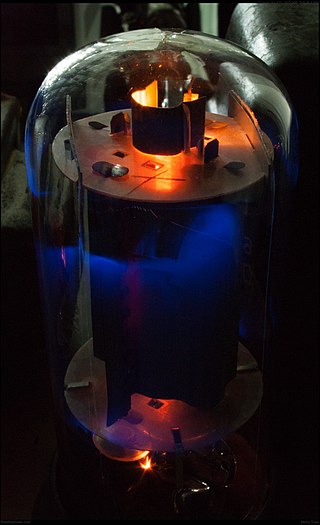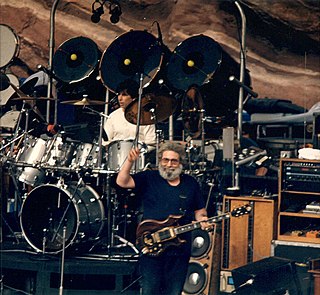This article needs additional citations for verification .(March 2023) |
This is a list of notable valve amplifier designs.
This article needs additional citations for verification .(March 2023) |
This is a list of notable valve amplifier designs.

The first commercially produced amplifier with distortion of 0.1% was the LEAK Type 15 "Point One" of 1945, using KT66 vacuum tubes (valves) connected as triodes, with 26 dB feedback over 4 stages including the output transformer. In 1948 LEAK produced the TL/12 which was also rated at 0.1% but featured improved performance with 26 dB over 3 stages and the output transformer (giving better gain-margin and phase-margin). The TL/12 sold in large quantities to professional users, radio stations, laboratories, as well as to the emerging market for hi-fi equipment. It is highly prized even today by audio enthusiasts.
The Williamson amplifier was published in 1947 as an article in Wireless World , and was a milestone which defined the mainstream topology for the majority of amplifiers thereafter. The design gave particular attention to a very high specification for the output transformer, in addition to being generally a consistently well worked-through design. It was not itself originally a commercial design, but many commercial versions and derivatives were subsequently made (with and without due credit).
To promote their new 9-pin tubes EZ80, EF86 and EL84, the Anglo-Dutch Mullard Company developed, in 1954, a famous and very popular mono amplifier circuit, the Mullard 5-10. The design featured 5 tubes with 10 watts output: EF86 as preamplifier, ECC83 phase-splitting, two EL84 in push-pull configuration, EZ80 rectifier. The amplifier used the excellent Partridge output transformer and was well known for its great sound reproduction.
Dynaco was a major US manufacturer of completed and kit amplifiers of high quality, notably of the Mark III and the Stereo 70, claimed to be the most popular tube amp ever made with over 300,000 produced.

McIntosh Laboratory long held a reputation for producing very high quality high-end equipment in the US. The model MC275 was produced from May 1961 through July 1973.
The model MC275 perhaps demonstrates most clearly the revival in tube amplifiers, as used MC275s in mint condition can sell for up to eight times their original purchase price, and a "Commemorative Edition" made during the 1990s was priced at $4000. [1]
Another historic manufacturer of valve amplifiers was Marantz. The Marantz 8B is another design that has been considered a classic and for which a "Reissue" edition has been produced.

Compactrons are a type of thermionic valve, or vacuum tube, which contain multiple electrode structures packed into a single enclosure. They were designed to compete with early transistor electronics and were used in televisions, radios, and similar roles.

An amplifier, electronic amplifier or (informally) amp is an electronic device that can increase the power of a signal. It is a two-port electronic circuit that uses electric power from a power supply to increase the amplitude of a signal applied to its input terminals, producing a proportionally greater amplitude signal at its output. The amount of amplification provided by an amplifier is measured by its gain: the ratio of output voltage, current, or power to input. An amplifier is a circuit that has a power gain greater than one.

A valve amplifier or tube amplifier is a type of electronic amplifier that uses vacuum tubes to increase the amplitude or power of a signal. Low to medium power valve amplifiers for frequencies below the microwaves were largely replaced by solid state amplifiers in the 1960s and 1970s. Valve amplifiers can be used for applications such as guitar amplifiers, satellite transponders such as DirecTV and GPS, high quality stereo amplifiers, military applications and very high power radio and UHF television transmitters.
The Williamson amplifier is a four-stage, push-pull, Class A triode-output valve audio power amplifier designed by D. T. N. Williamson during World War II. The original circuit, published in 1947 and addressed to the worldwide do it yourself community, set the standard of high fidelity sound reproduction and served as a benchmark or reference amplifier design throughout the 1950s. The original circuit was copied by hundreds of thousands amateurs worldwide. It was an absolute favourite on the DIY scene of the 1950s, and in the beginning of the decade also dominated British and North American markets for factory-assembled amplifiers.

A beam tetrode, sometimes called a beam power tube, is a type of vacuum tube or thermionic valve that has two grids and forms the electron stream from the cathode into multiple partially collimated beams to produce a low potential space charge region between the anode and screen grid to return anode secondary emission electrons to the anode when the anode potential is less than that of the screen grid. Beam tetrodes are usually used for power amplification, from audio frequency to radio frequency. The beam tetrode produces greater output power than a triode or pentode with the same anode supply voltage. The first beam tetrode marketed was the Marconi N40, introduced in 1935. Beam tetrodes manufactured and used in the 21st century include the 4CX250B, KT66 and variants of the 6L6.
McIntosh Laboratory is an American manufacturer of handcrafted high-end audio equipment based in Binghamton, New York. The company was founded in 1949 by Frank McIntosh. The company designs and produces audio amplifiers, stereo tuners and other consumer electronics products.
Founded by David Hafler and Ed Laurent in Philadelphia, Pennsylvania in 1955, Dynaco was an American hi-fi audio system manufacturer popular in the 1960s and 1970s for its wide range of affordable, yet high quality audio components.. Its best known product was the ST-70 tube stereo amplifier. They also manufactured other tube and solid state amplifiers, preamplifiers, radio tuners and bookshelf loudspeakers. Dynaco was liquidated in 1980, and the trademark is now owned by Radial Engineering Ltd.

A pentode is an electronic device having five electrodes. The term most commonly applies to a three-grid amplifying vacuum tube or thermionic valve that was invented by Gilles Holst and Bernhard D.H. Tellegen in 1926. The pentode was developed from the screen-grid tube or shield-grid tube by the addition of a grid between the screen grid and the plate. The screen-grid tube was limited in performance as an amplifier due to secondary emission of electrons from the plate. The additional grid is called the suppressor grid. The suppressor grid is usually operated at or near the potential of the cathode and prevents secondary emission electrons from the plate from reaching the screen grid. The addition of the suppressor grid permits much greater output signal amplitude to be obtained from the plate of the pentode in amplifier operation than from the plate of the screen-grid tube at the same plate supply voltage. Pentodes were widely manufactured and used in electronic equipment until the 1960s to 1970s, during which time transistors replaced tubes in new designs. During the first quarter of the 21st century, a few pentode tubes have been in production for high power radio frequency applications, musical instrument amplifiers, home audio and niche markets.
LEAK is the brand name for high-fidelity audio equipment made by H. J. Leak & Co. Ltd, of London, England. The company was founded in 1934 by Harold Joseph Leak and was sold to the Rank Organisation in January 1969. During the 1950s and 1960s, the company produced high-quality amplifiers, radio tuners, loudspeakers, pickups, arms and a turntable. The sale of the business to Rank saw an expanded range of models, and considerable further development of loudspeakers, but Rank was not able to position the brand to counter competition from Japanese electronics manufacturers, so by the late 1970s, electronics and speaker production ceased under the LEAK name.

The EL34 is a thermionic vacuum tube of the power pentode type. The EL34 was introduced in 1955 by Mullard, who were owned by Philips. The EL34 has an octal base and is found mainly in the final output stages of audio amplification circuits; it was also designed to be suitable as a series regulator by virtue of its high permissible voltage between heater and cathode and other parameters. The American RETMA tube designation number for this tube is 6CA7. The USSR analog was 6P27S.

A single-ended triode (SET) is a vacuum tube electronic amplifier that uses a single triode to produce an output, in contrast to a push-pull amplifier which uses a pair of devices with antiphase inputs to generate an output with the wanted signals added and the distortion components subtracted. Single-ended amplifiers normally operate in Class A; push-pull amplifiers can also operate in Classes AB or B without excessive net distortion, due to cancellation.
A radio transmitter or just transmitter is an electronic device which produces radio waves with an antenna. Radio waves are electromagnetic waves with frequencies between about 30 Hz and 300 GHz. The transmitter itself generates a radio frequency alternating current, which is applied to the antenna. When excited by this alternating current, the antenna radiates radio waves. Transmitters are necessary parts of all systems that use radio: radio and television broadcasting, cell phones, wireless networks, radar, two way radios like walkie talkies, radio navigation systems like GPS, remote entry systems, among numerous other uses.

The Mullard 5-10 was a circuit for a valve amplifier designed by the British valve company, Mullard in 1954 at the Mullard Applications Research Laboratory (ARL) in Mitcham Surrey UK, part of the New Road factory complex, to take advantage of their particular products. The circuit was first published in Practical Wireless magazine.
A valve audio amplifier (UK) or vacuum tube audio amplifier (US) is a valve amplifier used for sound reinforcement, sound recording and reproduction.
Ultra-linear electronic circuits are those used to couple a tetrode or pentode vacuum-tube to a load.
Technical specifications and detailed information on the valve audio amplifier, including its development history.
Circlotron valve amplifier is a type of power amplifier utilizing symmetrical cathode-coupled bridge layout of the output stage. Original circlotrons of 1950s used output transformers to couple relatively high output impedance of vacuum tubes to low-impedance loudspeakers. Circlotron architecture, easily scalable, was eventually adapted to operate without output transformers, and present-day commercially produced circlotron models are of output transformerless (OTL) type.

Tube sound is the characteristic sound associated with a vacuum tube amplifier, a vacuum tube-based audio amplifier. At first, the concept of tube sound did not exist, because practically all electronic amplification of audio signals was done with vacuum tubes and other comparable methods were not known or used. After introduction of solid state amplifiers, tube sound appeared as the logical complement of transistor sound, which had some negative connotations due to crossover distortion in early transistor amplifiers. However, solid state amplifiers have been developed to be flawless and the sound is later regarded neutral compared to tube amplifiers. Thus the tube sound now means 'euphonic distortion.' The audible significance of tube amplification on audio signals is a subject of continuing debate among audio enthusiasts.
A Virtual Valve Amplifier (VVA) is software algorithm designed and sold by Diamond Cut Productions, Inc. for simulating the sound of various valve amplifier designs. It can be found within their DC8 and Forensics8 software programs.

The McIntosh MC-2300 is a solid-state power amplifier which was built by the American high-end audio company McIntosh Laboratory between 1971 and 1980.